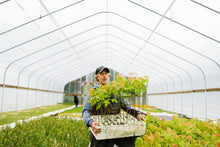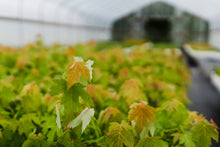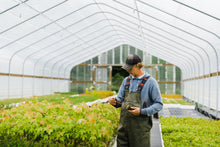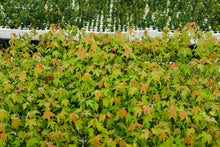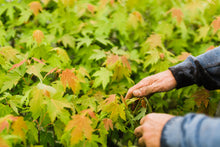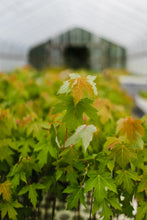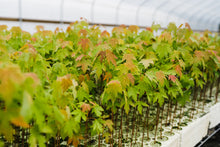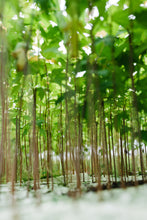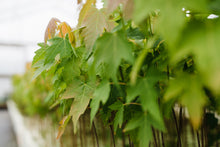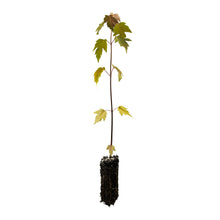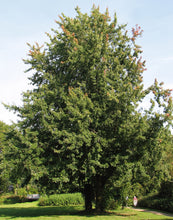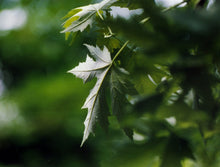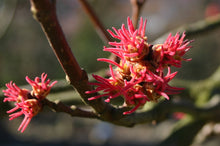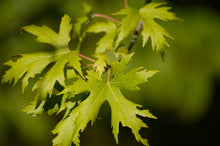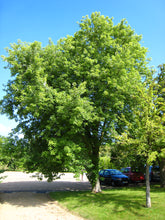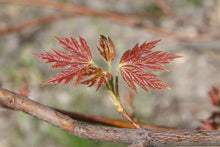
Acer saccharinum
- Grow your own Silver Maple, an adaptable, fast-growing maple from the eastern United States
- Bulk tree deal for landscaping projects, windbreaks, restoration and reforestation work, and other large-scale plantings
- Seed-grown on California's Redwood Coast
- Transplanting and care instructions included
 |
Moisture Medium |
 |
Cold Hardiness -40°F |
 |
Light Full Sun |
 |
Size 90 – 140' tall / 50 – 80' spread |
 |
Lifespan 130 yrs |
 |
Growth Rate Fast Growing |
 |
Drought Tolerance Low |
 |
Wind Resistance Low |
About Silver Maple
From the U.S. Dept. of Agriculture:
"A native tree reaching to mature heights of 90-140 feet, usually with a short, thick trunk and spreading, open, irregular crown of long, curving branches with pendulous branchlets turning up at the ends; twigs produce a slightly unpleasant odor when crushed; bark gray and thin, becoming furrowed into long, shaggy, scaly ridges on older trunks and branches. The National Registry of Big Trees reports a specimen in Michigan that is 115 feet tall with a circumference of 347 inches. Silver maples can live to 130 years or longer. The leaves are deciduous, opposite, 4-6 in long and nearly as wide, long-petioles, deeply 5-lobed and long-pointed (middle lobe often 3-lobed) with V-shaped sinuses, doubly toothed, with three main veins from the base, dull green above, silvery-white beneath, usually turning pale yellow or soft gold in the autumn, occasionally scarlet and crimson (perhaps reflecting hybridization with red maple).
Silver maple has been heavily planted as an ornamental in many urban areas because of its ease of transplanting and establishment, adaptability to a wide range of sites, rapid growth, and good form. The species also has been used for vegetative rehabilitation of surface mined lands as well as for bottomland reforestation.
The abundant seeds of silver maples are eaten by many birds, including evening grosbeaks, finches, wild turkeys, ducks, and other game birds, and small mammals, especially squirrels and chipmunks. The buds are an important food for squirrels when stored food is depleted, particularly in late winter and early spring. The bark is a food source for beavers and deer, and rabbits browse the foliage. Silver maple tends to develop cavities that are used by cavity-nesting birds and mammals and provide shelter and breeding habitat for many other species, including raccoons, opossums, squirrels, owls, woodpeckers, and many other birds. Because of its abundance and the wide distribution of silver maple, its early produced pollen may be important to the biology of bees and other pollen dependent insects. Most references describe silver maple as wind pollinated, but insect pollination may be important, as many insects, especially bees, visit the flowers."
About Jonsteen's Seedlings
All of our trees are seed-grown at our nursery on California's Redwood Coast, which is inspected monthly and licensed by the California Department of Agriculture. Trees can provide a natural barrier against high winds, temperatures, noise pollution and soil erosion, all while benefiting local air quality, wildlife and property values — a Jonsteen seedling will only grow in value and beauty!
About Jonsteen's Nursery Lots
Periodically, we offer great deals on bulk lots of select species to make room in the nursery for our new crop. It's a great way for us to keep things moving while rewarding our most prolific tree-planting customers. Are you thinking about a larger-scale landscaping, windbreak, restoration or reforestation project? This deal was made for you!
Seedling Size Chart: Medium
Due to the dynamic nature of actively growing trees, as well as the tremendous variation between species’ growth rates, we rely on the cubic volume of a seedling’s root mass to determine its “size” (Small / Medium / Large / XL). Within each size there is minor variance — the dimensions provided here represent the category minimum. If exact measurements are essential, please contact us about current stock.


















